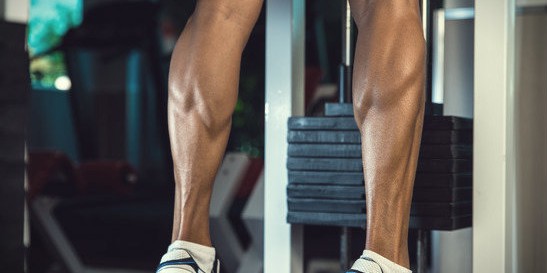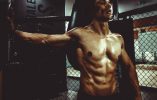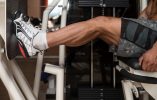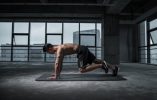The Ultimate Workout Guide to Get the Perfect Legs

We all know that guy who’s in the gym religiously, broad shoulders, thick barrel chest and arms that stretch his shirt sleeves but tiny sticks for legs. For him, every day is upper body, never venturing near the squat rack except to violate that most sacred law of the iron,
“no curling in the squat rack”.
It’s a shame because in his quest for the perfect physique he’s leaving at least half of his muscle building and fat burning potential on the table. The quads, hamstrings and glutes are some of the largest, most powerful, muscles in the body. Lower body strength is so important that it’s pretty common for beginner and novice lifters to increase their upper body strength simply by increasing their lower body strength.
If you’re still not convinced that training the legs is important because you think girls dont care about legs and you’re only working out to look good and pick up girls. You’re 100% wrong. She’s checking out your legs and butt too, you just didn’t know it.
The Squat, King of All Exercises:
The squat has long been revered as the “King of All Exercises” for good reason, It’s easily one of the most effective. But many swear off squatting because they’re either scared to get hurt or they just dont wnat to commit to it. The truth is, squatting takes a certain level of focus and intestinal fortitude that most other exercises don’t require. If you don’t know what I’m talking about, try a set of 20 rep breathing squats and you’ll understand. Squatting, like any exercise, can be dangerous if it’s done incorrectly. Here’s how to do a good squat.
In the Rack:
Get the shoulders tight, shoulder blades pinched together and pulled down “into the back pockets”. That should create a “shelf” on the shoulders or upper back for the bar to sit on. Without lifting the bar out of the rack, dig the shoulders into the bar. The goal is to make you and the bar one with each other.
Get the hands as close to the shoulders as you can comfortably and grip the bar as hard as possible. This will help maintain tightness in the upper back and the shelf for the bar to sit on.
Try to have the bar at a level in the rack where you can just push the hips under you slightly to unrack the bar. Don’t get into a practice of having to quarter squat or reach up onto your toes to unrack the bar.
The Setup:
Once you’ve unracked the bar, take 3 steps away from the rack. Small first step, larger second and the third is to even up the feet.
You should end up with the feet about shoulder width apart and the toes turned out anywhere from 10-20 degrees. Your stance, like most aspects of squatting, is very individual, so find what works best for you.
Feel the weight in your heels and think about “rooting” yourself into the floor by screwing your feet out, pushing the knees out, externally rotating the legs from the hip.
The Descent:
Take a deep breath into the belly and hold it. Push the hips back slightly and “open” the hips hard by screwing the feet out against the floor, hard, the whole time. If you keep the knees lined up with the toes you’ve opened the hips hard enough. Sit as deep as you can maintain a neutral lower back (slight arch is fine) without discomfort.
On the Way Up:
Think about leading out of the bottom with your shoulders first. This will help keep the hips from shooting up and folding you over. Continue to drive the hips out hard and press the belt buckle forward until you’re standing tall. Make sure your hips are under, not behind, you at the top with your glutes fully engaged.
Remember:
- Maintain upper back tightness, always pull the shoulder blades together and crush the bar hard.
- Hips move back, before knees move at all on the descent.
- Always open the hip aggressively, keeping the knees in line with the toes.
- Don’t overarch the low back, try to maintain a neutral spine the whole time.
If you’re aiming for glute development, depth matters. Getting the hips as low as possible, usually the top crease of the hip below the top of the knees is necessary to get maximal glute activation and development in the squat.
Squatting doesn’t have to be with just a bar on the back. A Goblet Squat with a dumbbell or kettlebell held high in front of the chest is a great variation for beginners to learn the proper squatting mechanics or for the advanced to use as a warmup or workout finisher. Front Squats can be a great way to challenge the core and mid back as well as the legs and are usually more low back friendly when compared to back squats.
While squats may be king there, are plenty of other exercises that are leg training royalty too. Some of my other go to exercises for building leg mass include:
Lunges:
If you’ve ever tried to sit on the toilet or walk up a couple flight of stairs the day after doing lunges you’ve experienced the intense soreness that your quads and glutes can get from these. For some, lunges can be hard on the knees. If that’s the case for you, stick to reverse lunges, where you’re stepping back instead of forward and really focus on keeping the weight in the heel of the front foot.
If you’re looking for an awesome way to absolutely fry your legs at the end of a workout try Parking Lot Lunges, made famous by 8 time Mr. Olympia Ronnie Coleman. Basically, go find a parking lot and do walking lunges for as long as you can, trying to make it all the way across. Your goal should be to increase that distance each week for however long you’re willing to torture yourself.
Romanian Deadlifts:
When trying to build the hamstrings, glutes and low back, the Romanian Deadlift (RDL) might be the best exercise. RDL’s can be superior to conventional deadlifts, for muscle building, because they accentuate the eccentric (lowering) portion of the lift, and tend to have a larger time under tension. Both of which are known to increase muscle damage and lead to growth.
When performing RDL’s be sure to maintain a vertical shin, keep the core braced, low back in neutral and don’t allow the arms to just hang on the bar. Keep some tension on the back side of the shoulders in the upper back and lats. Really focus on hinging the hips, pushing back, loading the glutes and hamstrings and having a smooth movement.
Hip Thrust:
Butts are the body part of 2015. They’re so “it” right now that there is even a term for the butt selfie (belfie). So you want one. Not only will your back feel better and your pants will finally stay up, once you have one. Your girlfriend might not mind those unexpected ass grabs as much if she has something to grab back at. That’s where the Hip Thrust comes in.
Start with your shoulders on the bench, driving through your heels, squeezing the glutes. Press the hips up into full extension. If body weight is too easy try doing the single leg version or add weight with a barbell across the hips. If you do add a barbell, make sure you use padding on the bar. The last thing you want is bruised hip bones from the bar. An Airex pad, rolling a yoga mat around the bar or a Squat Sponge all work well.
One two most common mistakes that many people make with the barbell hip thrust is to go too heavy or they let their ribcage flare up at the top. Try to find a weight where you can really control the movement and maintain tension on the glutes, getting a super hard glute squeeze at the top of the movement with the ribcage “down” on the abs. That’s going to give most people the best results. If you get ass cramps after a set, you did it right.
Bulgarian Split Squats:
The Bulgarian Split Squat is the reigning king of leg hate. The key to these is depth. If you really sit into them and get the hips below the knee your quads and glutes will be on fire the next day. The two greatest strengths of the BSS are that the hip flexors get a great “active” (loaded) stretch and the glutes are forced to work and stabilize the hip, due to the single leg stance.
When performing these remember four things.
- Have the back foot pulled far enough forward on the bench so the back ankle will clear the bench.
- Initiate the movement from the hip.
- Have proper toe –ankle-knee-hip alignment the whole time.
- Don’t overarch the low back out of the bottom.
The BSS is a very versatile movement that can be done unloaded as a warmup , loaded heavy for low reps 3-5, moderately for high reps 8+ or even as AMAP (as many as possible) sets as a finisher at the end of the workout.
Generally I like to start leg days with a heavy, compound, bi-lateral (two legged), lift like Squats, RDL’s or Deadlifts working up to one to three heavy sets of 3-5 reps. Followed by my single leg lifts. Lunges, BSS or Single Leg Deadlifts in the 8-15 rep range for 3-5 sets. Then finishing leg workouts with something for a lagging area like a hip thrust variation if I need more glutes or leg presses if I need some more quads. Weak spots are focused on for 1-2 sets of 12-25 reps trying to reach absolute failure each time.
“Legs feed the wolf” –Herb Brooks, Head Coach 1980 US Olympic Hockey Team.
It doesn’t matter if you’re playing sports or just trying to build an awesome physique. You must train your legs if you’re going to get the results you’re after. Next time you’re about to walk past the squat rack and go bench press for the third time this week, take a minute, throw some plates on the bar, and give it a ride. It’ll be hard. Your lungs and legs will be on fire. But stick with it, suffer through it, and the improvement in your physique and performance will speak for itself.



